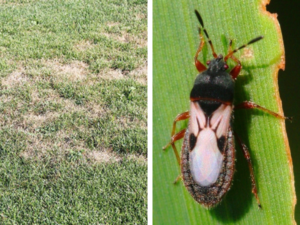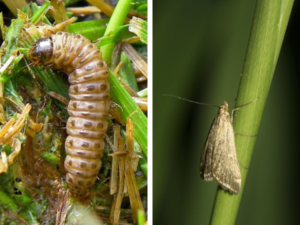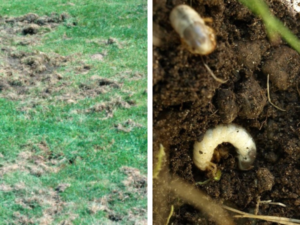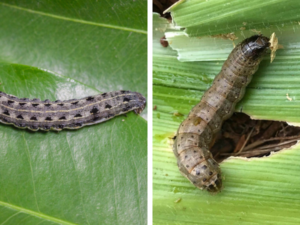Insects love your lawn almost as much as you do, and if you aren’t careful they can do a lot of damage that’s challenging to repair. Unless you are an entomologist (a bug scientist), insects may not be your thing. However, it’s important to know a little about them so you understand what steps you should take to keep them at bay.
Lawn-eating insects can be broken down into two major groups according to where they feed: surface-feeding insects take their meals on the surface of the lawn and are easily visible when you inspect your lawn; subsurface insects favor the roots of your grass, making detection and control more difficult.
Chinch Bugs

Damage appears as patchy areas of turf that turn yellow over time. As feeding progresses, the turf dries out, turns brown and appears drought stressed.
Chief among the surface feeders is the small-yet-mighty chinch bug. The adult is black with an hourglass-shaped design on its back and is about the size of a pencil tip. Chinch bugs can be seen scurrying about in large numbers during the heat of the summer. They damage grass by removing its sap and injecting their saliva during feeding. These lawn pests can cause widespread damage if not controlled.
Chinch bug infestations frequently occur in turfgrass with thick thatch that is exposed to full sunlight during periods of hot, dry weather. Chinch bug damage is often less noticeable during the spring and early summer. Damage frequently appears from early July through late August when the insects are actively feeding.
Sod Webworms

Damage typically starts as irregular spots marked by very short grass, which goes from green to brown without yellowing. The spots enlarge quickly and grass dies.
Sod webworms are tiny, wheat-colored moths that are most obvious when you are mowing your lawn. If you see small moths flying in a zig-zag pattern around your lawn mower, those are sod webworms. Unlike many insects, the adults are not the ones causing all the problems. During their larval stage, sod webworms come out at night to feed on your lawn — but their damage is often masked by new grass growth. Usually it’s only when lawns go dormant that severe infestations are detected.
One of the first signs of webworm infestation is small, ragged brown spots in the turf. Upon closer inspection, these areas will have a grazed or scalped appearance. As webworms continue growth and feed, the injured areas enlarge and coalesce. Under heavy sod webworm pressure, large areas of turf can be defoliated and even killed during periods of summer heat and drought. While sod webworm larvae are active from early spring through fall, the most serious turfgrass injury usually occurs in mid to late summer.
Cutworms and Armyworms
Cutworms and armyworms are both big, fleshy caterpillars that love to feed upon grass and leafy crops. These pests are not normally problematic in lawns — unless their populations explode! When their numbers reach biblical proportions, great hordes of caterpillars move en masse across lawns, leaving no green plant untouched. In fact, the name “armyworm” comes from this behavior: they march across lawns, leaving a trail of devastation in their wake.
Most species of cutworms feed from the ground, where they mow down plants by chewing through their stems. In some cases, they will attack the roots and cut down the plant below the soil level. Check for toppled plants that have been cut of at or near the bottom. If a cutworm doesn’t manage to chew all the way through the bottom of a plant, the top may still wither and die.[4] If you notice a wilted plant, check the base of the stem for cuts or notches.
Billbugs
Billbugs are weevils that spend their winters hiding in leaf litter along the edges of lawns. In the spring, they return to the lawn to lay their eggs in the sheaths of grass plants. The emerging larvae, termed “grubs,” are white and legless, with copper-colored heads. These newly-hatched grubs feast upon the growing point of the grass plants, which kills the grass. Diagnosing billbugs in a lawn is often challenging, as the grubs are quite small and are located deep within the thatched layer of the lawn.
Billbug larvae begin feeding on grass blades, hollowing out the stems, which causes grass to turn yellow. As the larvae mature, they will move down to the crown and thatch, and may also eat the roots and root system of the grass. Damaged grass will become discolored, and may appear in random spots throughout your yard, and grass will be easily pulled up. Extensive damage can kill grass.
White Grubs

White grubs feed on grass roots (and organic matter in the soil), causing sections of grass in the lawn to die. Grubs eventually turn into adult Beetles and emerge from soil to mate and lay eggs.
White grubs are the larvae of various species of scarab beetles. Most of these species have a one-year life cycle, meaning that they lay eggs during the summer months and then the hatching larvae feed upon grass roots for the remainder of the fall. When temperatures begin to drop as winter approaches, the grubs descend into the soil to avoid being frozen. As the frost recedes in the spring, the grubs return to feed upon the grass roots once again. This emphasizes the importance of being vigilant every year for new infestations.
White grubs cause damage by severing the root system of grass plants, preventing the plants from drawing enough water from the soil. The severed roots make it possible to detect grubs in the soil. Affected areas become brown;when pulled on, the grass will roll back like a carpet, revealing the grubs in the soil.
Treatment and Control
Lawns can successfully support a number of insects feeding upon them without any signs or symptoms because the lawn is growing faster than the insects can damage it. However, there comes a point when that threshold is passed and the damage becomes obvious. There are certainly ways to control problems once detected, and there are preventive measures you can take if your yard or neighborhood has a history of certain pests, like grubs. To learn more about protecting your yard from destructive pests, contact TriGuard Pest Control.





